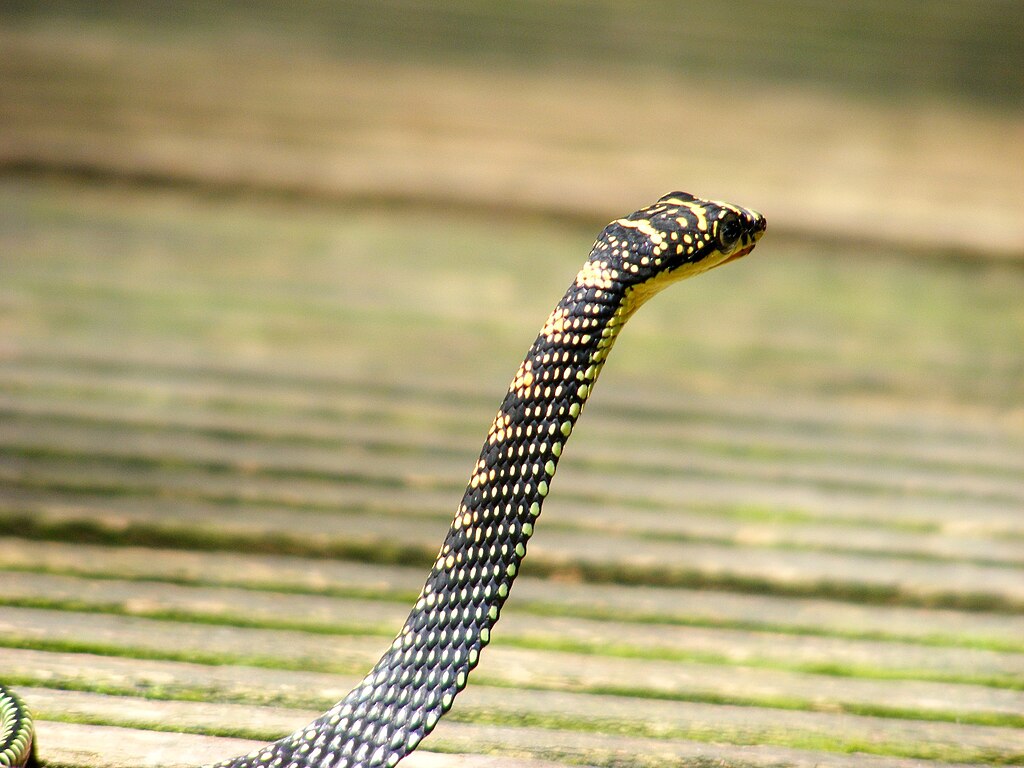In the remarkable theater of nature, few performances are as mesmerizing as the midair acrobatics of the paradise tree snake. This slender reptile has perfected an extraordinary skill that defies our expectations of how snakes move – the ability to twist and contort its body while falling, effectively transforming itself into a living glider. This fascinating adaptation not only showcases the incredible diversity of locomotion strategies in the animal kingdom but also challenges our understanding of physics and biomechanics. Let’s explore the remarkable story of this aerial serpent and discover how and why it developed such an unusual talent for flight.
The Paradise Tree Snake: Nature’s Aerial Acrobat
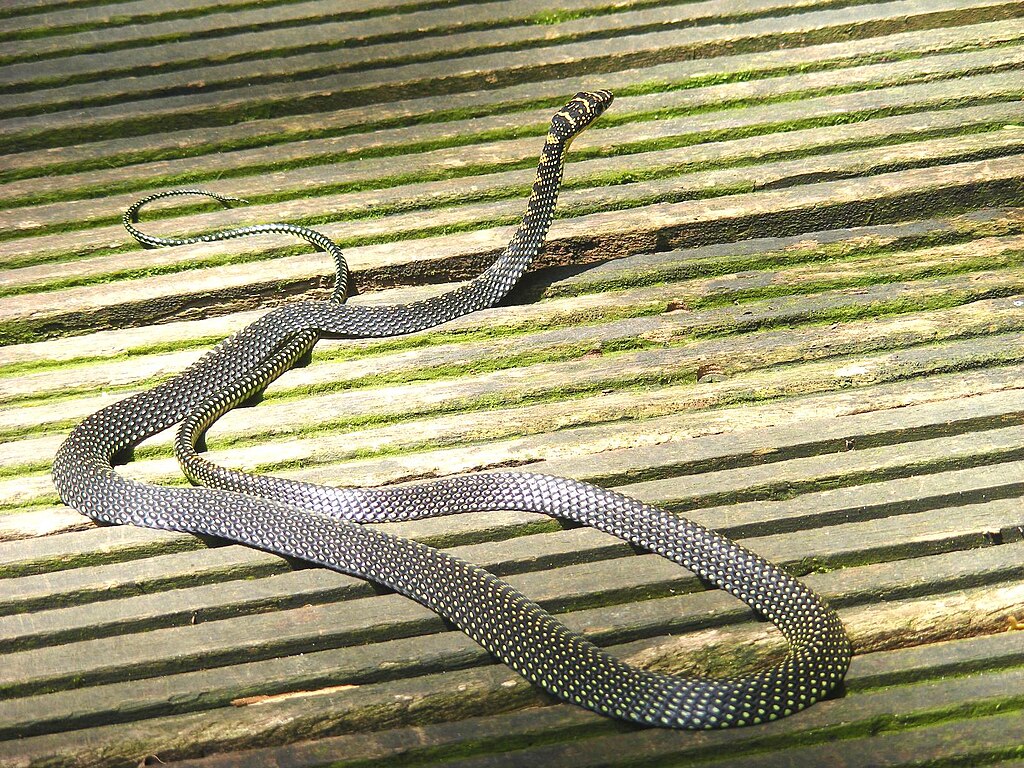
The paradise tree snake (Chrysopelea paradisi) belongs to a select group of reptiles known as “flying snakes,” though they don’t truly fly in the strict sense of the word. Native to South and Southeast Asia, these remarkable creatures inhabit forests where their arboreal lifestyle has led to the evolution of specialized gliding capabilities. With a slender body typically measuring between 2 and 4 feet in length and adorned with vibrant green, black, and sometimes red patterns, the paradise tree snake is as visually striking as its aerial abilities are impressive. While many arboreal snakes can fall with some degree of control, none have mastered the art of aerial locomotion quite like this species, which can traverse distances of up to 100 feet in a single glide.
The Science Behind Snake Gliding
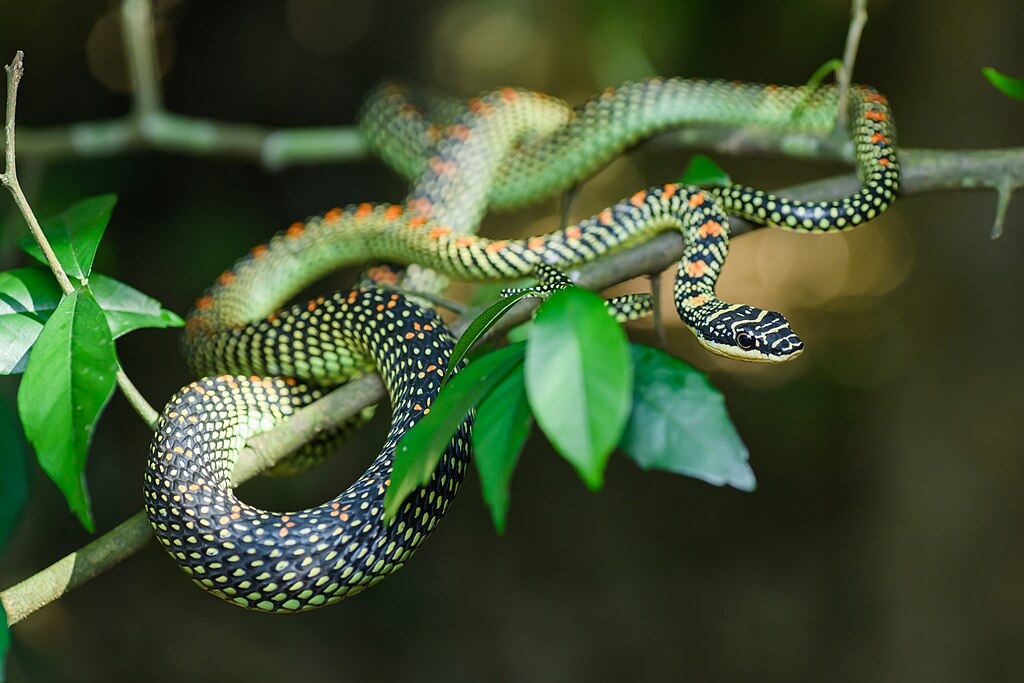
When a paradise tree snake launches itself from a branch, it doesn’t simply fall – it transforms its entire body into a functional wing. The snake flattens its body by spreading its ribs outward, effectively doubling its width while creating a concave shape on its underside that generates lift. This reshaping creates an airfoil similar to an airplane wing, with the snake’s body displacing air in ways that generate forces to counteract gravity. What makes this feat even more remarkable is that the snake achieves this transformation without any specialized anatomical structures like the flaps of skin found in flying squirrels or the modified limbs of flying lizards. Instead, the paradise tree snake uses only its existing anatomy – ribs, muscles, and scales – repurposed to conquer the air.
The Crucial Midair Twist

The most fascinating aspect of the paradise tree snake’s aerial repertoire is its ability to perform controlled twists while gliding. Upon jumping from a perch, the snake immediately initiates an undulating, wave-like motion combined with rapid twists of its body at precise angles. These twists aren’t random flailing but carefully coordinated movements that serve critical aerodynamic functions. Research by scientists at Virginia Tech revealed that these movements generate the necessary forces to stabilize the snake during its descent. Without these twists, the snake would tumble uncontrollably, but with them, it maintains a remarkable degree of stability and control throughout its glide, challenging our understanding of what’s physically possible for a limbless creature.
The Physics of Snake Flight

The paradise tree snake’s aerial maneuvers represent a fascinating study in biomechanics and fluid dynamics. When the snake twists in midair, it creates complex vortices and pressure differentials around its body that influence its trajectory. The snake’s flattened cross-section acts as an unconventional but effective airfoil, while its undulating movements alter the airflow patterns around it. Recent research using sophisticated high-speed cameras and 3D motion analysis has revealed that these snakes achieve a glide angle of about 13 degrees, allowing them to travel significant horizontal distances relative to their vertical drop. Even more remarkably, they can make mid-flight adjustments to navigate around obstacles or target specific landing spots, demonstrating a level of aerial control that was previously thought impossible for limbless animals.
Evolutionary Advantages of Aerial Locomotion

The ability to glide offers the paradise tree snake several significant evolutionary advantages in its forest habitat. Perhaps most importantly, it provides an efficient means of traveling between trees without having to descend to the forest floor, where these snakes would face different predators and challenges. Gliding allows them to conserve energy while covering distances that would otherwise require much more physical exertion. This adaptation also enhances their hunting capabilities, enabling them to pursue prey across gaps in the canopy that might otherwise serve as escape routes. Additionally, the ability to launch quickly into a glide serves as an effective escape mechanism when the snake itself is threatened, allowing it to rapidly remove itself from danger in three-dimensional space rather than being limited to fleeing along branches.
Research Breakthroughs in Understanding Snake Flight
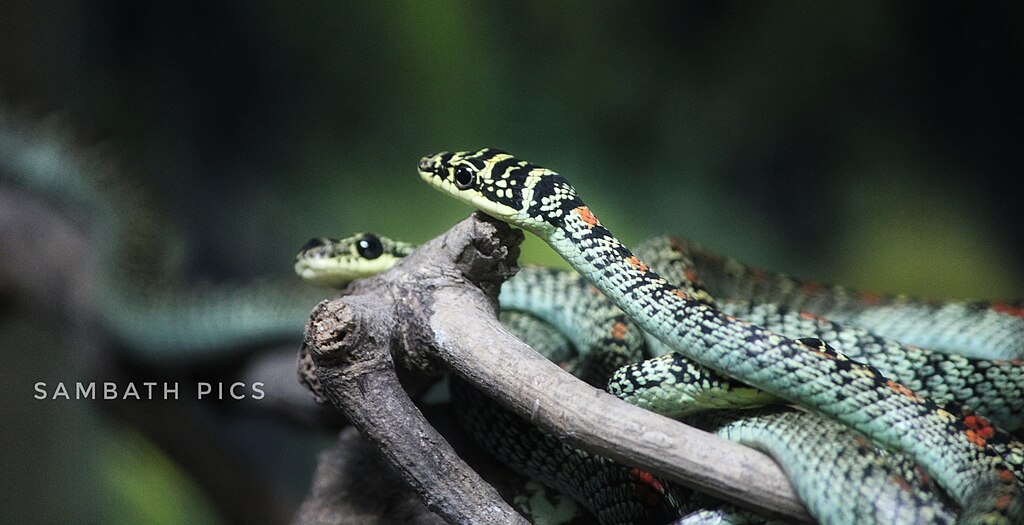
Scientific understanding of the paradise tree snake’s aerial abilities has advanced dramatically in recent decades through rigorous research and technological innovation. In groundbreaking studies led by Dr. Jake Socha at Virginia Tech, researchers used multiple high-speed cameras to capture the snakes’ movements from different angles simultaneously, allowing for precise 3D reconstruction of their flight paths. These studies revealed that the snakes use a combination of undulation (wave-like movement) and body twisting to generate aerodynamic forces. Further research involving wind tunnel experiments with 3D-printed models of the snakes helped scientists understand how air flows around the snake’s body during flight. Computational fluid dynamics simulations have further illuminated the complex interplay between the snake’s movements and the resulting aerodynamic forces, helping explain how a limbless animal can achieve such controlled aerial locomotion.
The Role of Scales in Snake Flight
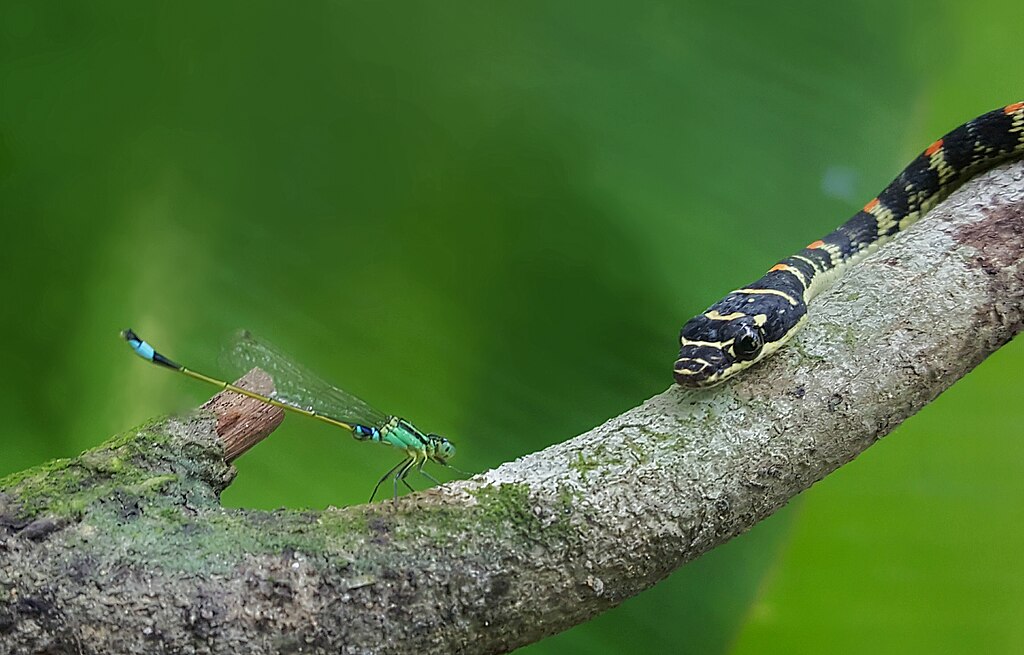
The paradise tree snake’s scales play a crucial role in its gliding abilities, featuring specialized adaptations that enhance aerodynamic performance. Unlike many other snakes, flying snakes possess scales with microscopic ridges that may help control airflow around the body during flight. The ventral (belly) scales in particular have unique structures that potentially reduce drag and increase stability when the snake is in its flattened gliding position. These scales also provide the necessary friction when the snake launches itself from a branch, ensuring a powerful initial jump. The arrangement of scales creates a textured surface that interacts with air in complex ways, potentially generating small vortices that enhance lift or stability – similar to how dimples on a golf ball improve its aerodynamic properties.
From Launch to Landing: The Complete Glide Sequence
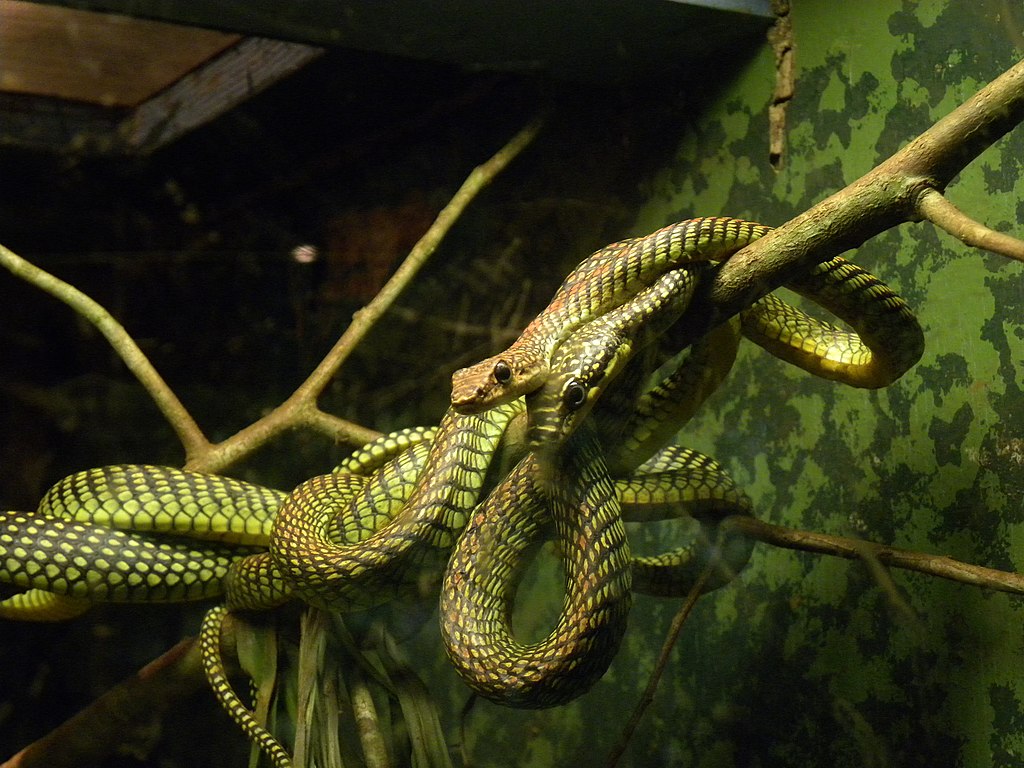
The paradise tree snake’s aerial journey follows a remarkable sequence of precisely coordinated behaviors. The process begins with a calculated launch, where the snake dangles its front portion from a branch before propelling itself forward with a powerful push from its rear body. As it enters free fall, the snake immediately flattens its body by spreading its ribs and begins the distinctive undulation that will characterize its entire flight. Within the first fraction of a second, it initiates the critical body twists that stabilize its trajectory, preventing uncontrolled tumbling. Throughout the glide, the snake continuously adjusts these movements in response to air currents and obstacles, effectively “swimming” through the air. As it approaches its target landing site – typically another tree – the snake prepares by adjusting its body angle and position, before finally making contact and quickly securing itself with a muscular grip, completing a journey that blends precision, physics, and evolutionary adaptation.
Flying Snakes Around the World
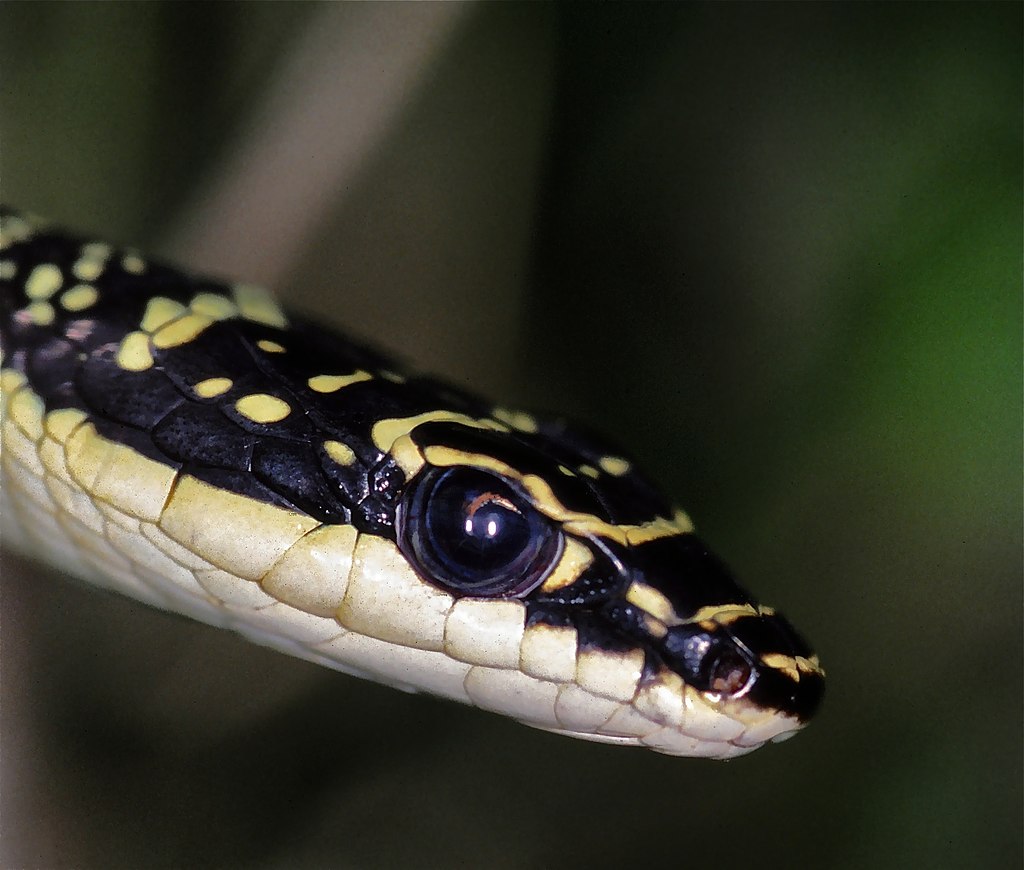
While the paradise tree snake is the most studied and perhaps the most accomplished aerial serpent, it is just one of several species in the genus Chrysopelea capable of this remarkable form of locomotion. Five species of flying snakes have been identified across South and Southeast Asia, each with slightly different gliding abilities and physical characteristics. The golden tree snake (Chrysopelea ornata) is another accomplished glider with striking yellow patterning, while the twin-barred tree snake (Chrysopelea pelias) features distinctive paired markings along its length. These flying snake species occupy varied but overlapping ranges across countries including India, Thailand, Malaysia, Indonesia, and the Philippines, primarily in tropical forest habitats where trees provide both the necessary launch platforms and the arboreal lifestyle that drove the evolution of their gliding abilities. Despite their shared gliding capabilities, each species has evolved subtle differences in technique and efficiency that reflect their specific ecological niches.
Conservation Status and Threats

The paradise tree snake and its flying relatives face growing conservation challenges as their forest habitats come under increasing pressure. Throughout Southeast Asia, rapid deforestation for agriculture, urban development, and logging has fragmented and reduced the continuous forest canopy these aerial specialists rely on for their distinctive mode of transportation. Without sufficient tree cover and appropriate gaps between trees, the evolutionary advantage of gliding becomes diminished, potentially affecting these species’ ability to hunt, escape predators, and maintain viable populations. While flying snakes are not currently listed as endangered, habitat loss remains their primary threat, and continued monitoring is essential to ensure their survival. Some populations may also face pressures from collection for the exotic pet trade, where their unusual abilities make them desirable specimens despite the challenges of caring for them properly in captivity.
Cultural Significance and Human Perceptions

Flying snakes have inspired awe, fear, and fascination across various cultures in their native ranges. In some traditional belief systems of Southeast Asia, these aerial serpents are considered mystical or supernatural beings, sometimes associated with both protective and dangerous spiritual forces. Their ability to move through the air has contributed to folklore and mythology about flying serpents across multiple cultures. In modern times, videos of these snakes in flight have become viral sensations, introducing millions of viewers worldwide to their remarkable abilities and challenging common perceptions about snake locomotion. Despite their harmless nature – flying snakes are mildly venomous but not dangerous to humans – their unusual capabilities sometimes reinforce snake-related fears and misconceptions. Conservation educators have increasingly used the flying snake’s fascinating abilities as a gateway to broader discussions about snake ecology and the importance of protecting these misunderstood reptiles.
Inspirations for Biomimetic Engineering
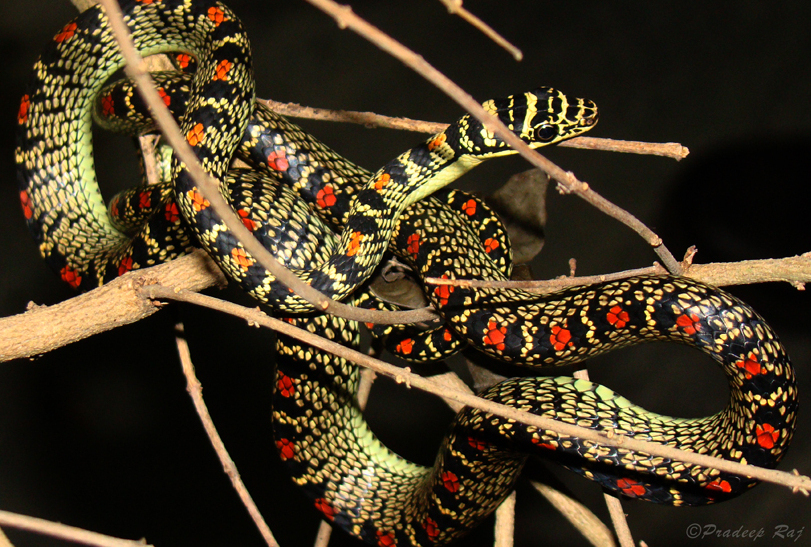
The paradise tree snake’s extraordinary gliding mechanism has captured the attention of engineers and roboticists seeking inspiration from nature for new technologies. Several research teams are studying these snakes’ movements to develop snake-inspired robots capable of aerial locomotion in addition to ground movement. Such robots could potentially navigate complex environments inaccessible to conventional drones or ground vehicles, with applications in search and rescue, structural inspection, and exploration. The snake’s ability to control its flight without dedicated wings or limbs offers valuable insights for designing minimalist flying devices with fewer mechanical components. Aerospace engineers have also examined the snake’s flattening mechanism and undulatory movements for potential applications in deployable wings or adaptive control surfaces that could change shape during flight. This field of biomimetics – drawing engineering inspiration from biological systems – continues to find valuable lessons in the paradise tree snake’s elegant solution to aerial locomotion.
Future Research Directions

Despite significant advances in understanding the paradise tree snake’s aerial abilities, many questions remain unanswered and continue to drive ongoing research. Scientists are particularly interested in the sensory mechanisms that allow these snakes to navigate while gliding, including how they process visual information and potentially use other senses to maintain orientation and select landing targets. Neurobiologists are investigating the complex neural control systems that coordinate the precise body movements required for stable gliding. Advanced computational models are being developed to fully simulate and predict the aerodynamics of snake flight under various conditions. Field researchers are exploring how environmental factors like forest structure influence gliding behavior and success rates, while evolutionary biologists continue to trace the genetic and morphological changes that enabled this remarkable adaptation to emerge. As research techniques advance, we can expect even deeper insights into one of nature’s most unexpected and elegant solutions to the challenge of aerial movement.
Conclusion

The paradise tree snake represents one of nature’s most extraordinary evolutionary innovations – a limbless reptile that conquered the air through ingenious adaptation of existing anatomy. Its ability to twist midair during falls showcases the remarkable diversity of locomotion strategies that have evolved on our planet. Beyond simply being a biological curiosity, these flying snakes offer valuable insights for fields ranging from biomechanics and aerodynamics to robotics and conservation. As we continue to study and protect these aerial acrobats, they remind us that evolution’s solutions to life’s challenges can emerge in the most unexpected forms, challenging our preconceptions about what’s possible in the natural world. The twisting, gliding paradise tree snake soaring between tropical trees stands as a testament to nature’s boundless creativity and the remarkable adaptability of life on Earth.

